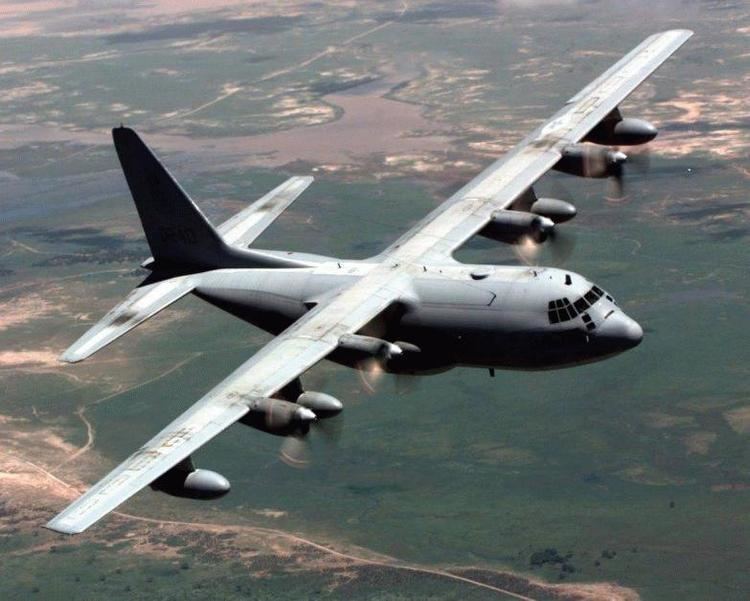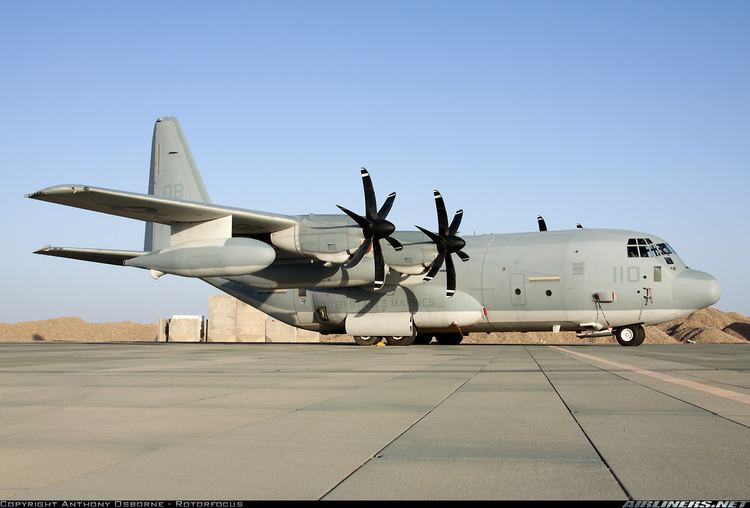Top speed 670 km/h | Wingspan 40 m | |
 | ||
Manufacturers Lockheed Corporation, Lockheed Martin | ||
The Lockheed Martin KC-130 is the basic designation for a family of the extended-range tanker version of the C-130 Hercules transport aircraft modified for aerial refueling. The KC-130J is the latest variant operated by the United States Marine Corps, with 48 delivered out of 79 ordered. It replaced older KC-130F, KC-130R, and KC-130T variants, while one USMC reserve unit still operates 12 KC-130T aircraft.
Contents
- Development
- Design
- KC 130J
- Harvest HAWK
- Operational history
- Variants
- Operators
- Specifications KC 130J
- References

Development

The KC-130F made its first test flight in January 1960 as the GV-1 under the old Navy designation system. First entering service in 1962, the KC-130F was designed to undertake aerial refueling missions in support of USMC aircraft. It was developed from the Lockheed C-130 Hercules.

The newest Hercules, the KC-130J, shares 55 percent of the same airframe as preceding models, but in fact is a greatly improved airplane. It is based on the Lockheed Martin C-130J Super Hercules and provides significant increases in operational capability and performance margins over preceding KC-130F/R/T (legacy) aircraft. Additionally, The KC-130J reduces cost of ownership through system reliability and reduced maintenance man-hours per flight hour.
The new HC-130J combat rescue tanker and MC-130J special operations tanker are both derived from a KC-130J baseline.

Technological development has led to the incorporation of interior/exterior night vision lighting, night vision goggle head-up displays, global positioning system, and jam-resistant radios. Some KC-130s are also equipped with defensive electronic and infrared countermeasures systems.
Design
The KC-130 is a multi-role, multi-mission tactical tanker/transport which provides the refueling support required by the USMC for its aircraft. This versatile asset provides in-flight refueling to both tactical aircraft and helicopters within a 500-nautical-mile (930 km) operating radius, as well as rapid ground refueling when required. Additional tasks performed are aerial delivery of troops and cargo, emergency resupply into unimproved landing zones within the objective or battle area, emergency medical evacuation, tactical insertion of combat troops and equipment, and evacuation missions.
KC-130J
The KC-130J offers a 60,000 pound fuel capacity that it can allocate between its own flight requirements against aerial refueling offload capacity using its wing and external tanks while in the air. When more fuel is needed, an additional 24,392 pounds of fuel can be offloaded from a specially configured internal fuselage 3,600-gallon aluminum fuel tank. The system also functions without the fuselage tank, so the cargo compartment can be used for cargo on the same mission, giving the aircraft even greater flexibility.
The aircraft is ready to fuel fixed-wing, tilt-rotor, or rotary-wing aircraft using the standard probe and drogue technique. The two wing-mounted hose and drogue refueling pods (made by Sargent Fletcher) can each transfer up to 300 gallons per minute to two aircraft simultaneously allowing for rapid cycle times of multiple-receiver aircraft formations (a typical tanker formation of four aircraft in less than 30 minutes).
The KC-130J also provides for rapid ground refueling of helicopters, vehicles and fuel caches. The aircraft has a unique propeller feathering feature (known as “hotel mode”, derived from the term hotel electric power, when a vessel or other means of transport is equipped with a power plant with the sole purpose of generating electric power for lighting, etc., rather than propulsion) which can slow (at 25% rotation speed) the propellers while the turbines continue to run and energize the generator, providing power to the electric fuel pumps. This reduction of the propellers' speed helps to eliminate prop wash behind the KC-130J. This allows ground forces to operate in relative calm while the aircraft offloads up to 600 gallons (4,018 pounds) per minute.
The U.S. Marine Corps has chosen the KC-130J to replace its aging KC-130 legacy tanker fleet. The new KC-130J offers increased utility and much needed improvement in mission performance. As a force multiplier, the J-model tanker is capable of refueling both fixed- and rotary-wing aircraft as well as conducting rapid ground refueling. The refueling speed envelope has been widened from 100 to 270 knots (500 km/h) indicated airspeed, offering more capability and flexibility. Offload rates per refueling pod can be up to 300 gallons per minute simultaneously. The KC-130's offload is significantly greater than previous Hercules tankers. As an example, at 1,000 nautical miles (1,852 km), the fuel offload is well over 45,000 pounds (20,412 kg).
Harvest HAWK
With the addition of the Marine Corps's ISR / Weapon Mission Kit, the KC-130J will be able to serve as an overwatch aircraft and can deliver ground support fire in the form of Hellfire or Griffin missiles, precision-guided bombs, and eventually 30mm cannon fire in a later upgrade. This capability, designated as "Harvest HAWK" (Hercules Airborne Weapons Kit), can be used in scenarios where precision is not a requisite, such as area denial.
The AN/AAQ-30 Target Sight System (TSS) integrates an infrared and television camera, and is mounted under the left wing's external fuel tank. It is the same TSS used on the upgraded AH-1Z Viper attack helicopter . The typical loadout is four Hellfire missiles and 10 Griffin GPS guided missiles. The weapons systems operator uses a Fire Control Console mounted on an HCU-6/E pallet in the KC-130J’s cargo compartment.
The aircraft retains its original capabilities in refueling and transportation. The entire system can be removed in less than a day if necessary. The USAF MC-130W Dragon Spear program uses a similar concept.
The USMC plans to acquire three kits per active-duty KC-130J squadron for a total of nine kits, each costing up to US$22 million. It was first test flown on 29 August 2009 by VX-20, and first deployed in October 2010 with VMGR-352.
Operational history
The KC-130 has supported operations in the Vietnam War,the Falklands War for Argentina, Operation Desert Shield, Operation Desert Storm, Operation Enduring Freedom, Operation Iraqi Freedom and other USMC operations over the last fifty years.
VMGR-252, Cherry Point, NC, was the first fleet squadron to transition to the KC-130J. Contrary to most military squadrons when they transition to a new aircraft, VMGR-252 did not "stand down" to train and equip for the new airframe. Quite the contrary, they continued full-time fleet support with their "legacy" Hercs until fully converted to the J model. This trend was continued by squadrons as they transitioned to the KC-130J.
In February 2005, VMGR-252 made the first operational combat deployment of the KC-130J when six aircraft were deployed to Al Asad, Iraq in support of Operation Iraqi Freedom. During this time VMGR-252 experienced many "firsts" with the new J model conducting aerial refueling, delivery of cargo and passengers, the first combat aerial delivery of supplies by any J model user (the USAF subsequently conducted aerial delivery in Afghanistan with their new J models later that year) and battlefield illumination. VMGR-252 maintained the sole KC-130J presence for a year while VMGR-352 took delivery of and transitioned to the J model. The semi-permissive threat environment and the state of the art defensive systems of the J model permitted it to operate over the battlefield, providing fuel for the jets close to the fight, versus the tanker being far behind the lines in relative sanctuary. On more than one occasion VMGR-252 aircraft came under fire from insurgents, as did VMGR-352 aircraft during subsequent deployments to Iraq.
In 2006, VMGR-252 and 352 shared a joint detachment in Iraq and this paradigm continued for a number of years. In the summer of 2006, VMGR-252 provided a two KC-130J detachment in support of the 24th Marine Expeditionary Unit (24MEU) to RAF Akrotiri in Cyprus during the Lebanon/Israeli conflict that summer. Also during this time VMGR-252 began extensive operational training and tactics development with the new MV-22 Osprey, refining long range tanker procedures with the new tilt-rotor aircraft.
In Spring 2008, VMGR-252 again made KC-130J history by providing the KC-130J aircraft detachment to 24MEU as they reestablished the USMC presence in Kandahar, Afghanistan. This deployment experienced numerous great KC-130J successes conducting all manner of expeditionary type missions routinely landing at austere dirt runways, tactical aerial delivery of goods, and the traditional logistic support and refueling missions that are the hallmark of USMC KC-130 support.
Though the USMC KC-130Js have left Iraq, a continuing KC-130J presence has now been maintained in support of Operation Enduring Freedom in Afghanistan, with aircraft and crews provided by both VMGR-252 and 352 during different periods. In May 2009, the Okinawa-based "SUMOS" of VMGR-152 provided two aircraft and crews to support the OEF presence. This was VMGR-152's first operational combat deployment since Vietnam, and they have been maintaining a continuing presence in Afghanistan with VMGR-352/252.
USMC KC-130J aircraft from VMGR-252 and 352 have additionally been deployed to Djibouti for operations in the Horn of African supporting counter-terrorist operations in the region.
After the 2010 Pakistan floods, KC-130Js from USMC VMGR-352 squadron delivered over 200,000 pounds of cargo across Pakistan in support of flood relief efforts.
The Harvest Hawk weapons system for USMC KC-130J aircraft began its first deployment during October 2010 in Afghanistan with Marine Aerial Refueler Transport Squadron 352 (VMGR-352). Its first weapons engagement was on 4 November supporting the 3rd Battalion 5th Marines in Sangin. One Hellfire missile was fired and five enemy insurgents were killed. The battle damage assessment stated there were no civilian casualties or property damage during the fire fight.
A KC-130J from the 26th MEU participated in a pilot rescue during Operation Odyssey Dawn.
Variants
Operators
Specifications (KC-130J)
Data from Lockheed Martin KC-130J Super Tanker fact sheet,
General characteristics
Performance
